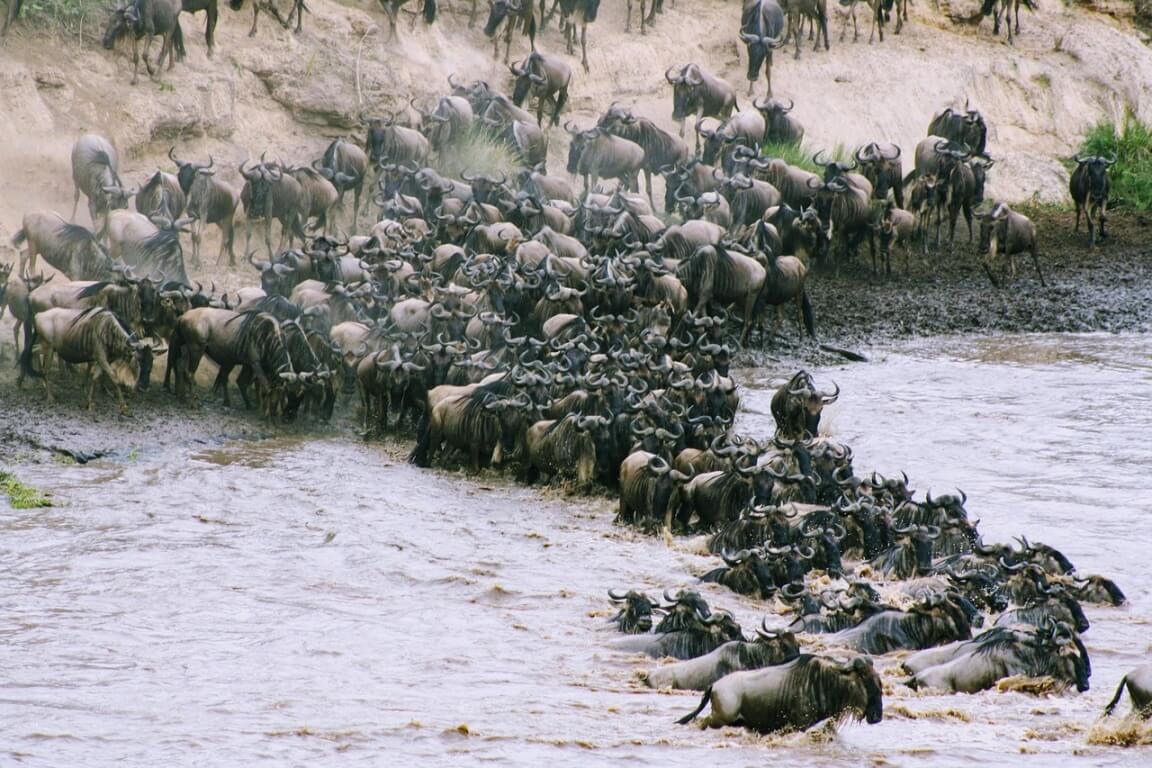The Ultimate Guide to the Great Wildebeest Migration: When, Where, and Why You Should Witness It
Every year, one of the most breathtaking natural events unfolds on the plains of East Africa. Over a million wildebeest, joined by hundreds of thousands of zebras and gazelles, embark on a continuous journey across the Serengeti in Tanzania and the Masai Mara in Kenya. This epic movement, known as the Great Wildebeest Migration, is one of the most dramatic wildlife spectacles on Earth.
Travelers from across the globe, especially from the United States, dream of witnessing this natural wonder. And with good reason. Few experiences can match the thrill of seeing wildebeest crossing crocodile-filled rivers, hearing the thunder of their hooves, or watching predators like lions and cheetahs waiting in the grasslands.
If you are planning an African safari, this guide will give you everything you need to know about the wildebeest migration: when it happens, where to see it, why it occurs, and how you can plan the perfect trip with Pleasant Adventures.
What is the Wildebeest Migration?
The wildebeest migration is the largest land animal migration in the world. Each year, around 1.5 million wildebeest, accompanied by over 200,000 zebras and hundreds of thousands of gazelles, move in search of fresh grazing and water.
This migration is not a single event. Instead, it is a year-round cycle, a constant movement between Tanzania’s Serengeti and Kenya’s Masai Mara. Wildebeests are always on the move, following the rains and the green grass.
The journey covers nearly 1,800 miles in a loop that repeats every year. Because of its scale, drama, and importance for global wildlife, many call it the Eighth Wonder of the World.
What Month is the Wildebeest Migration?
One of the most common questions travelers ask is: When does the wildebeest migration happen?
The truth is, it happens all year long. The herds don’t stop; they keep moving, month by month. But where you can see them changes with the seasons.
Here’s a simple calendar of the migration:
- January – March: Calving season in the southern Serengeti. Thousands of calves are born every day, attracting predators like lions, hyenas, and cheetahs.
- April – May: The herds spread across the central Serengeti, grazing as the rains continue. This is a quieter time, but still filled with action.
- June – July: The wildebeest start gathering for the famous river crossings. They move toward the Grumeti River in Tanzania.
- July – September: This is the peak season in Kenya’s Masai Mara. The herds cross the Mara River, where crocodiles wait in the waters and predators stalk from the banks.
- October – December: The animals head back toward Tanzania, completing the circle.
So, the best month to see the wildebeest migration depends on where you go. If you want to see the dramatic Mara River crossings, July to September in Kenya is ideal. If you want to experience the birthing season, visit the Serengeti in January to March.
For safari lovers, there is no wrong time — only different experiences.
Where is the Wildebeest Migration?
The wildebeest migration takes place across two countries: Kenya and Tanzania.
In Tanzania, the herds spend most of the year moving across the Serengeti. This vast park is famous for its endless plains and rich wildlife. In Kenya, the migration enters the Masai Mara, usually between July and October.
Many travelers ask: Which is better, Serengeti or Masai Mara?
The answer depends on what you want to see.
- The Serengeti offers a longer migration season, especially during calving.
- The Masai Mara offers some of the most dramatic river crossings and predator-prey encounters.
Both are spectacular, and many travelers choose to combine the two for a complete migration safari.
Where should you stay for the Great Migration? You can choose from luxury lodges, mid-range camps, or budget-friendly camping safaris. At Pleasant Adventures, we customize your safari based on your comfort and budget, ensuring you are in the right place at the right time.
And yes — it is absolutely worth seeing. Many people call it a life-changing experience.
Where Do the Wildebeest Migrate To and From?
The wildebeest migration is a circular journey.
- It starts in the southern Serengeti, where the animals give birth.
- It moves northward across the Serengeti as the grass dries up.
- Then it crosses into the Masai Mara in Kenya, where the animals find fresh grazing.
- Finally, the herds move back south again.
Are wildebeests always migrating? Yes. They are constantly moving, never staying in one place for long.
How many wildebeest are there in Africa? Over 1.5 million, joined by around 250,000 zebras and 400,000 gazelles.
Why do zebras migrate with wildebeest? Because they complement each other. Zebras eat the tougher grass, while wildebeest feed on the fresh shoots that follow. Together, they make survival easier.
Where is the best place to see the migration? The Mara River crossings in Kenya are the most famous, but calving in the Serengeti is equally unforgettable.
What is the Main Reason Wildebeest Migrate?
The wildebeest migration is driven by a simple need: food and water. The rains in East Africa are seasonal. When one area dries up, the herds move on to where the rains have fallen and fresh grass has grown.
How long does the migration take? It never ends. It is a continuous cycle.
Why does the Great Migration occur in Africa? Because East Africa’s ecosystem is unique. The Serengeti and Masai Mara are linked by weather patterns and landscapes that support this endless movement.
Is the wildebeest migration a wonder of the world? Yes, many people consider it the greatest wildlife spectacle on Earth.
But it’s not just about the animals. The migration is also about survival against predators. Lions, leopards, hyenas, and crocodiles all take advantage of the herds. Watching this raw drama unfold in the wild is what makes the migration unforgettable.
Why the Wildebeest Migration Should Be on Your Bucket List
Imagine standing on the banks of the Mara River. You hear the thunder of hooves. Dust rises in the air. Thousands of wildebeest gather, hesitant but desperate. Suddenly, one jumps in, and the others follow. The water churns with crocodiles. Lions wait on the other side.
This is not a scene from a movie. It is real. And it is happening in front of you.
The wildebeest migration is about more than wildlife. It is about nature at its rawest. It is about survival, courage, and the circle of life. For any traveler, especially from the USA, it is the ultimate adventure.
Planning Your Wildebeest Migration Safari
When planning a safari to see the migration, you have many options:
- Camping safari to Masai Mara: Perfect for adventure lovers and budget travelers.
- Luxury lodges: Ideal for those who want comfort with their adventure.
- Budget Kenya safari to top national parks: A great way to combine the migration with other parks like Amboseli, Tsavo, and Lake Naivasha.
Tips for planning:
- Book early — migration safaris fill up quickly.
- Pack light but include essentials: binoculars, camera, safari clothing, sunscreen.
- Travel with a trusted operator like Pleasant Adventures for safety and local expertise.
Why Book With Pleasant Adventures
At Pleasant Adventures, we believe every safari should be unique. That’s why we design tailor-made trips to match your interests, budget, and travel style.
- We work with local guides who know the land and wildlife.
- We ensure your comfort, safety, and enjoyment.
- We support conservation and local communities.
- We give you the best chance to be at the right place, at the right time.
Whether you want a luxury lodge safari, a camping adventure, or a mid-range option, we make it happen.
Conclusion
The wildebeest migration is more than just a safari highlight. It is one of the greatest shows on Earth. From the Serengeti plains to the Masai Mara rivers, it offers unmatched drama, beauty, and wildlife encounters.
There is no better time to make your dream safari come true. Let Pleasant Adventures take you closer to the action, where every trail tells a story and every moment is unforgettable.
Book your wildebeest migration safari today — and witness nature’s greatest wonder for yourself.




